Voltage Unbalance, Power Factor and Losses Optimization in Electrified Railways Using an Electronic Balancer
Abstract
:1. Introduction
2. Voltage Unbalance Factor, Power Factor and Losses
2.1. Voltage Unbalance in the Three-Phase Grid
2.2. Three-Phase Power Factor
2.3. Power Losses
3. Electronic Balancer
- (i)
- No compensation: There is no compensation of the unbalanced three-phase current; the system operates as is.
- (ii)
- Load current balancing: Only the negative sequence of the three-phase current is compensated by the Balancer.
- (iii)
- Load current balancing and power factor correction: The negative sequence () of the three-phase current is compensated for load balancing, and unitary power factor is reached by compensating the imaginary/reactive part of the positive sequence of the three-phase current.
4. Case Study #1: Seven Substations
4.1. Substation #7 with Conventional Feeding in Normal Operation
- In the scenario without compensation of the unbalanced current, the power factor in the three-phase grid has a reduction of compared with the single phase power factor at the TPSS (Figure 9a).
- With the compensation of the negative sequence of the unbalanced three-phase current, the power factor in three-phase grid increases by a factor of becoming equal to the load power factor (Figure 9b). Additionally, if reactive power compensation is set, then the grid power factor becomes unitary.
- Regarding power losses, the compensation of current’s negative sequence component has a consequence of losses decreasing around 50%. This losses’ decrease can be more noticeable by compensating to a unitary power factor in the three-phase grid, as shown in Figure 12.
4.2. Substation #4 in Degraded Mode
- Without any compensation of the unbalanced load current, the power factor in the three-phase grid has a reduction of compared with the single-phase power factor at the TPSS (Figure 15a).
- With the compensation of the negative sequence of the unbalanced three-phase current, the power factor in three-phase grid increases by a factor of becoming equal to the load power factor. Additionally, if reactive power compensation is used, then the grid power factor becomes unitary (Figure 15b).
- Regarding power losses, the compensation of the current’s negative sequence has a consequence of losses decreasing around 50%. This losses’ decrease can be more noticeable by compensating the power factor in the three-phase grid to one, as shown in Figure 17.
5. Case Study #2: Three Substations
Substation #2 in Normal Operation
6. Conclusions
Author Contributions
Funding
Institutional Review Board Statement
Informed Consent Statement
Data Availability Statement
Conflicts of Interest
Abbreviations
| DFIG | Doubly Fed Induction Generators |
| EHV | Extra-High Voltage |
| FACTS | Flexible AC Transmission Systems |
| FBD | Fryze Buchholz Depenbrock |
| HV | High Voltage |
| HSR | High Speed Railway |
| IEEE | Institute of Electrical and Electronics Engineers |
| IN2STEMPO | Innovative Solutions in Future Stations, Energy Metering and Power Supply |
| JU | Joint Undertaking |
| NSC | Negative Sequence Component |
| OOS | Out of Service |
| PCC | Point of Common Coupling |
| PF | Power Factor |
| PLL | Phase-Locked Loop |
| PR | Proportional plus Resonant |
| PSC | Positive Sequence Component |
| RPC | Rail Power Conditioner |
| S2R | Shift2Rail |
| SFC | Static Frequency Converter |
| STATCOM | Static Synchronous Compensator |
| SVC | Static Var Compensator |
| TPSS | Traction Power Substations |
| TSO/DSO | Transmission System Operator/Distribution System Operator |
| ZSC | Zero Sequence Component |
References
- Shift2Rail. Multi-Annual Action Plan; Publications Office of the European Union: Luxembourg, 2019. [Google Scholar] [CrossRef]
- European Comission. Innovative Solutions in Future Stations, Energy Metering and Power Supply. 2019. Available online: https://cordis.europa.eu/project/id/777515 (accessed on 10 October 2021).
- ABB. SVCs for Load Balancing and Trackside Voltage Control; Technical Report; ABB: Västerås, Sweden, 2010. [Google Scholar]
- Lee, S.Y.; Wu, C.J.; Chang, W.N. A compact control algorithm for reactive power compensation and load balancing with static Var compensator. Electr. Power Syst. Res. 2001, 58, 63–70. [Google Scholar] [CrossRef]
- Sainz, L.; Caro, E.; Riera, S. Characterization of Harmonic Resonances in the Presence of the Steinmetz Circuit in Power Systems. In Power Quality Harmonics Analysis and Real Measurements Data; Romero, G., Ed.; IntechOpen: London, UK, 2011; Chapter 7. [Google Scholar] [CrossRef] [Green Version]
- Konishi, S.; Baba, K.; Daiguji, M. Var Compensators. Fuji Electr. Rev. 2002, 48, 37–45. [Google Scholar]
- Grunbaum, R.; Halvarsson, P.; Thorvaldsson, B. Knowing the FACTS. ABB Rev. 2010, 2, 35–41. [Google Scholar]
- Gruber, R.; O’Brien, D. Use of Modular Multilevel Converter (MMC) Technology in Rail Electrification. In Proceedings of the AusRAIL 2014, Making Making Innovation Work, Perth, Australia, 11–12 November 2014. [Google Scholar]
- Hayashiya, H.; Kondo, K. Recent trends in power electronics applications as solutions in electric railways. IEEJ Trans. Electr. Electron. Eng. 2020, 15, 632–645. [Google Scholar] [CrossRef]
- Hu, S.; Wu, B.; Rehtanz, C.; Zhang, Z.; Chen, Y.; Zhou, G.; Li, Y.; Luo, L.; Cao, Y.; Xie, B.; et al. A New Integrated Hybrid Power Quality Control System for Electrical Railway. IEEE Trans. Ind. Electron. 2015, 62, 6222–6232. [Google Scholar] [CrossRef]
- Tokiwa, A.; Yamada, H.; Tanaka, T.; Watanabe, M.; Shirai, M.; Teranishi, Y. New Hybrid Static VAR Compensator with Series Active Filter. Energies 2017, 10, 1617. [Google Scholar] [CrossRef]
- Abrahamsson, L.; Schütte, T.; Östlund, S. Use of converters for feeding of AC railways for all frequencies. Energy Sustain. Dev. 2012, 16, 368–378. [Google Scholar] [CrossRef] [Green Version]
- Krastev, I.; Tricoli, P.; Hillmansen, S.; Chen, M. Future of Electric Railways: Advanced Electrification Systems with Static Converters for ac Railways. IEEE Electrif. Mag. 2016, 4, 6–14. [Google Scholar] [CrossRef]
- Sun, Z.; Jiang, X.; Zhu, D.; Zhang, G. A Novel Active Power Quality Compensator Topology for Electrified Railway. IEEE Trans. Power Electron. 2004, 19, 1036–1042. [Google Scholar] [CrossRef]
- Chen, M.; Li, Q.; Roberts, C.; Hillmansen, S.; Tricoli, P.; Zhao, N.; Krastev, I. Modelling and performance analysis of advanced combined co-phase traction power supply system in electrified railway. IET Gener. Transm. Distrib. 2016, 10, 906–916. [Google Scholar] [CrossRef]
- Uzuka, T.; Ikedo, S.; Ueda, K. A static voltage fluctuation compensator for AC electric railway. In Proceedings of the 2004 IEEE 35th Annual Power Electronics Specialists Conference (IEEE Cat. No.04CH37551), Aachen, Germany, 20–25 June 2004. [Google Scholar] [CrossRef]
- Tanta, M.; Pinto, J.G.; Monteiro, V.; Martins, A.P.; Carvalho, A.S.; Afonso, J.L. Topologies and Operation Modes of Rail Power Conditioners in AC Traction Grids: Review and Comprehensive Comparison. Energies 2020, 13, 2151. [Google Scholar] [CrossRef]
- Paszkier, B.; Zouiti, M.; Javerzac, J.L.; Perret, J.P.; Courtois, C. VSC based imbalance compensator for railway substations. In Proceedings of the 41st Session of the International Conference on Large High Voltage Electric Systems (CIGRE), Paris, France, 27 August 27–1 September 2006. [Google Scholar]
- Tanta, M.; Cunha, J.; Barros, L.A.M.; Monteiro, V.; Pinto, J.G.O.; Martins, A.P.; Afonso, J.L. Experimental Validation of a Reduced-Scale Rail Power Conditioner Based on Modular Multilevel Converter for AC Railway Power Grids. Energies 2021, 14, 484. [Google Scholar] [CrossRef]
- Bueno, A.; Aller, J.M.; Restrepo, J.A.; Harley, R.; Habetler, T.G. Harmonic and Unbalance Compensation Based on Direct Power Control for Electric Railway Systems. IEEE Trans. Power Electron. 2013, 28, 5823–5831. [Google Scholar] [CrossRef]
- He, Z.; Zheng, Z.; Hu, H. Power quality in high-speed railway systems. Int. J. Rail Transp. 2016, 4, 71–97. [Google Scholar] [CrossRef] [Green Version]
- Kaleybar, H.J.; Brenna, M.; Foiadelli, F.; Fazel, S.S.; Zaninelli, D. Power Quality Phenomena in Electric Railway Power Supply Systems: An Exhaustive Framework and Classification. Energies 2020, 13, 6662. [Google Scholar] [CrossRef]
- Oghorada, O.J.K.; Zhang, L. Unbalanced and Reactive Load Compensation Using MMCC-Based SATCOMs With Third-Harmonic Injection. IEEE Trans. Ind. Electron. 2019, 66, 2891–2902. [Google Scholar] [CrossRef] [Green Version]
- Yuan, J.; Xiao, F.; Zhang, C.; Chen, Y.; Ni, Z.; Zhong, Y. Collaborative unbalance compensation method for high-speed railway traction power supply system considering energy feedback. IET Power Electron. 2019, 12, 129–137. [Google Scholar] [CrossRef]
- Tareen, W.; Aamir, M.; Mekhilef, S.; Nakaoka, M.; Seyedmahmoudian, M.; Horan, B.; Memon, M.; Baig, N. Mitigation of Power Quality Issues Due to High Penetration of Renewable Energy Sources in Electric Grid Systems Using Three-Phase APF/STATCOM Technologies: A Review. Energies 2018, 11, 1491. [Google Scholar] [CrossRef] [Green Version]
- Chen, Y.; Chen, M.; Tian, Z.; Liu, Y.; Hillmansen, S. VU limit pre-assessment for high-speed railway considering a grid connection scheme. IET Gener. Transm. Distrib. 2019, 13, 1121–1131. [Google Scholar] [CrossRef]
- Chen, Y.; Chen, M.; Tian, Z.; Liu, Y. Voltage Unbalance Management for High-Speed Railway Considering the Impact of Large-Scale DFIG-Based Wind Farm. IEEE Trans. Power Deliv. 2020, 35, 1667–1677. [Google Scholar] [CrossRef]
- Xiao, D.; Minwu, C.; Yinyu, C. Negative Sequence Current and Reactive Power Comprehensive Compensation for Freight Railway Considering the Impact of DFIGs. CPSS Trans. Power Electron. Appl. 2021, 6, 235–241. [Google Scholar] [CrossRef]
- IEC. Electromagnetic Compatibility (EMC)-Part 3-13: Limits-Assessment of Emission Limits for the Connection of Unbalanced Installations to MV, HV and EHV Power Systems; IEC/TR 61000-3-13; IEC: Geneva, Switzerland, 2008. [Google Scholar]
- IEC. Electromagnetic compatibility (EMC)-Part 4-30: Testing and Measurement Techniques-Power Quality Measurement Methods; IEC/TR 61000-4-30; IEC: Geneva, Switzerland, 2008. [Google Scholar]
- Paap, G.C. Symmetrical components in the time domain and their application to power network calculations. IEEE Trans. Power Syst. 2000, 15, 522–528. [Google Scholar] [CrossRef]
- Chen, T.H. Criteria to estimate the voltage unbalances due to high-speed railway demands. IEEE Trans. Power Syst. 1994, 9, 1672–1678. [Google Scholar] [CrossRef]
- Plantive, E.; Courtois, C.; Javerzac, J.L.; Poirrier, J.P. Application of a 20 MVA STATCOM for voltage balancing and power active filtering of a 25 kV AC single-phase railway substation connected to the 90 kV grid in France. In Proceedings of the 38th Session of the International Conference on Large High Voltage Electric Systems (CIGRE), Paris, France, 27 August–1 September 2000. [Google Scholar]
- Simões, M.G.; Harirchi, F.; Babakmehr, M. Survey on time-domain power theories and their applications for renewable energy integration in smart-grids. IET Smart Grid 2019, 2, 491–503. [Google Scholar] [CrossRef]
- Depenbrock, M. The FBD-method, a generally applicable tool for analyzing power relations. IEEE Trans. Power Syst. 1993, 8, 381–387. [Google Scholar] [CrossRef]
- Willems, J.L. IEEE Standard 1459. IEEE Standard Definitions for the Measurement of Electric Power Quantities Under Sinusoidal, Nonsinusoidal, Balanced, or Unbalanced Conditions. In Proceedings of the 2010 IEEE International Workshop on Applied Measurements for Power Systems, Aachen, Germany, 22–24 September 2010. [Google Scholar] [CrossRef] [Green Version]
- Laka, A.; Cross, A.; Barrena, J.A.; Chivite-Zabalza, J.; Rodriguez, M.A. VSC topology comparison for STATCOM application under unbalanced conditions. In Proceedings of the 2013 15th European Conference on Power Electronics and Applications (EPE), Lille, France, 2–6 September 2013. [Google Scholar] [CrossRef] [Green Version]
- Hochgraf, C.; Lasseter, R.H. Statcom controls for operation with unbalanced voltages. IEEE Trans. Power Deliv. 1998, 13, 538–544. [Google Scholar] [CrossRef] [Green Version]
- Martins, A.P.; Morais, V.A.; Ramos, C.J. Analysis of the STATCOM/Balancer Robustness in Railway Applications. In Proceedings of the 2020 IEEE 14th International Conference on Compatibility, Power Electronics and Power Engineering (CPE-POWERENG), Setubal, Portugal, 8–10 July 2020. [Google Scholar] [CrossRef]
- Akagi, H.; Watanabe, E.H.; Aredes, M. Instantaneous Power Theory and Applications to Power Conditioning, 2nd ed.; John Wiley & Sons, Inc.: Hoboken, NJ, USA, 2017. [Google Scholar] [CrossRef]
- Kazmierkowski, M.; Malesani, L. Current control techniques for three-phase voltage-source PWM converters: A survey. IEEE Trans. Ind. Electron. 1998, 45, 691–703. [Google Scholar] [CrossRef]
- Zmood, D.; Holmes, D. Stationary frame current regulation of PWM inverters with zero steady-state error. IEEE Trans. Power Electron. 2003, 18, 814–822. [Google Scholar] [CrossRef]
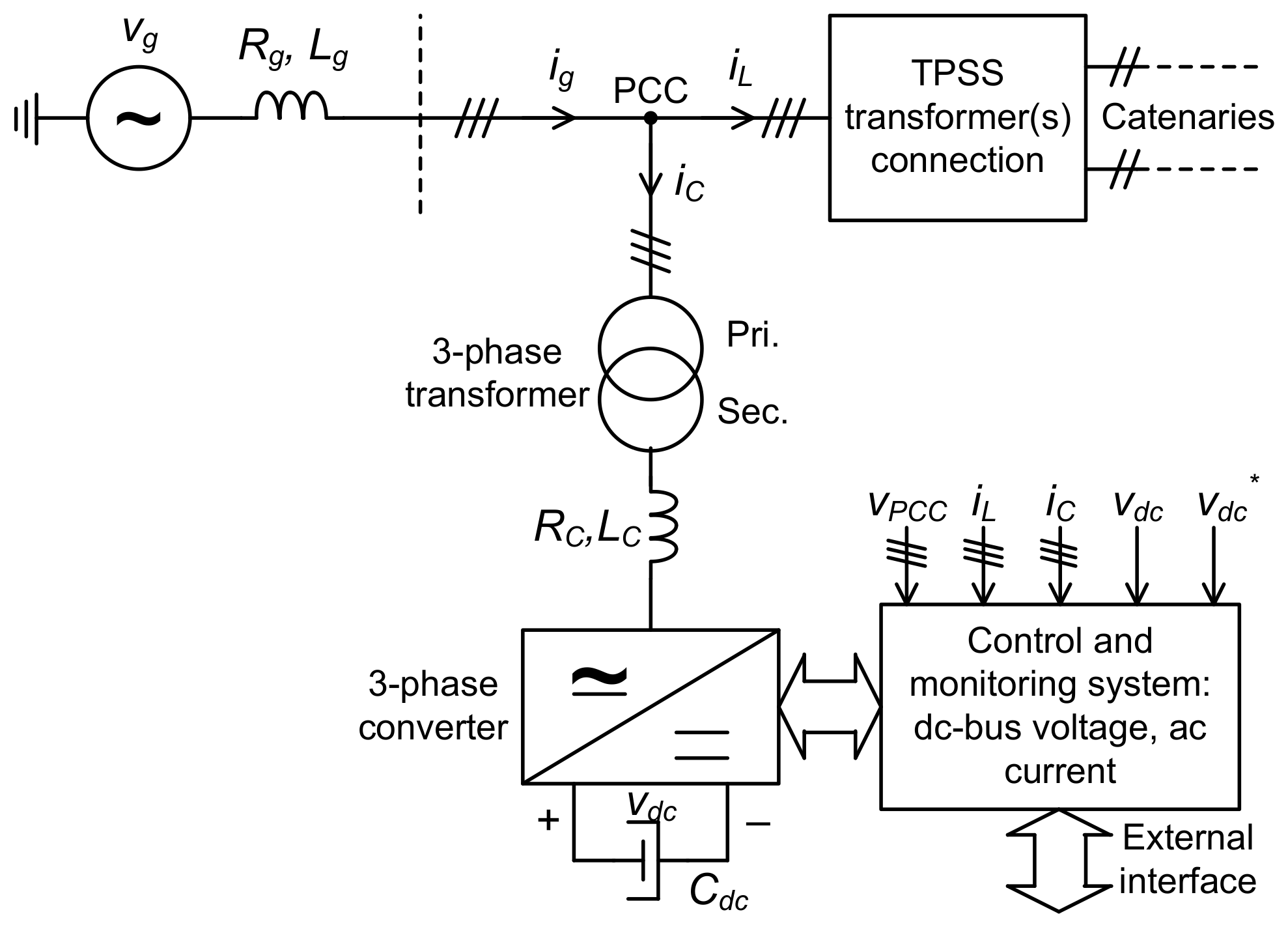
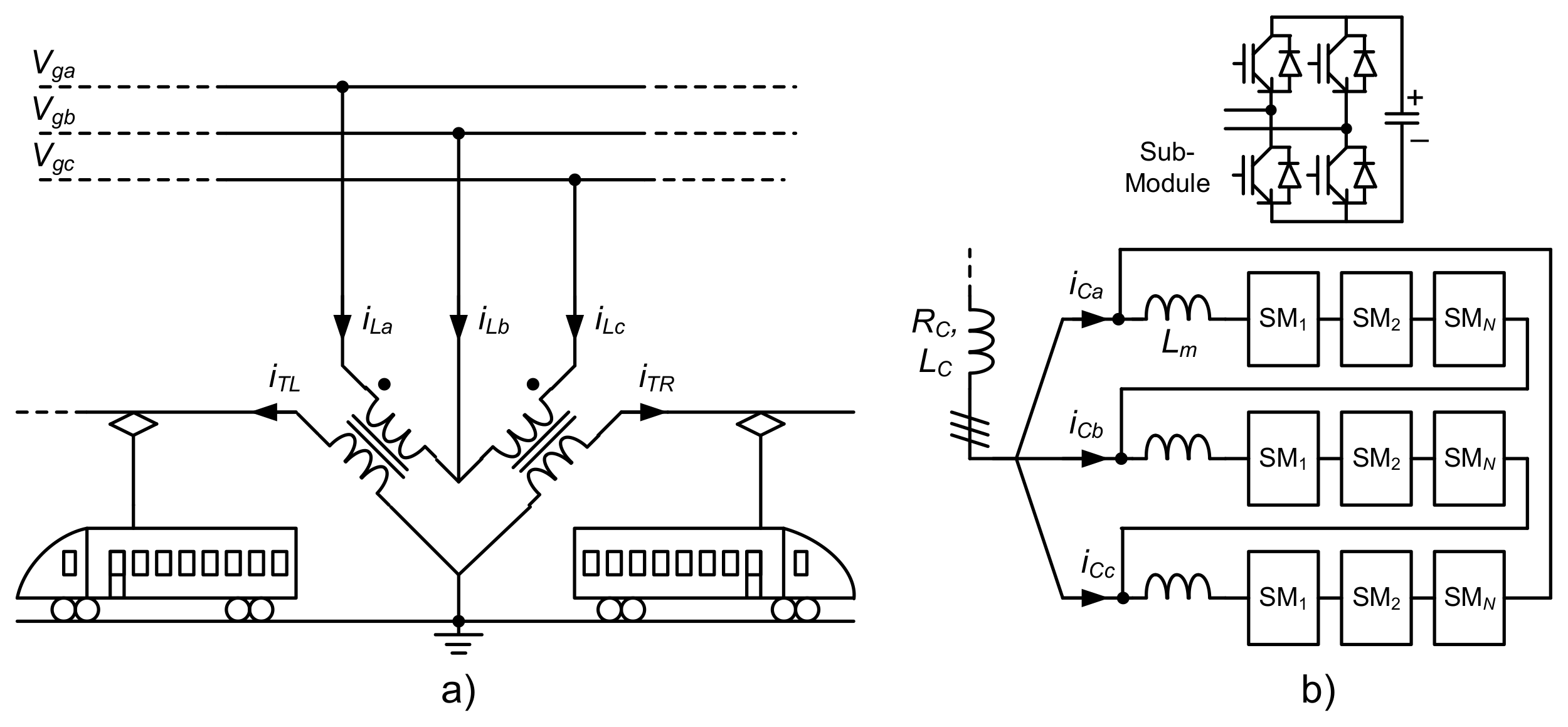
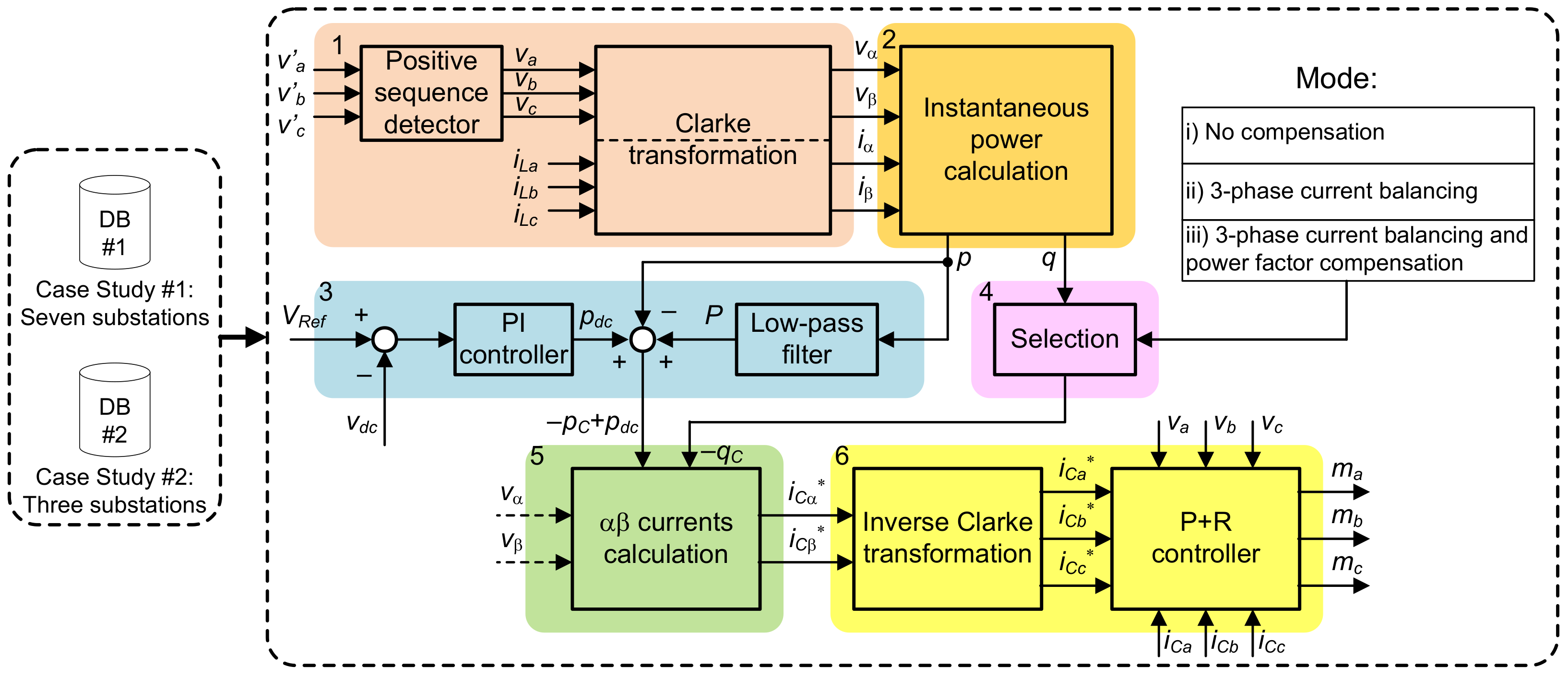

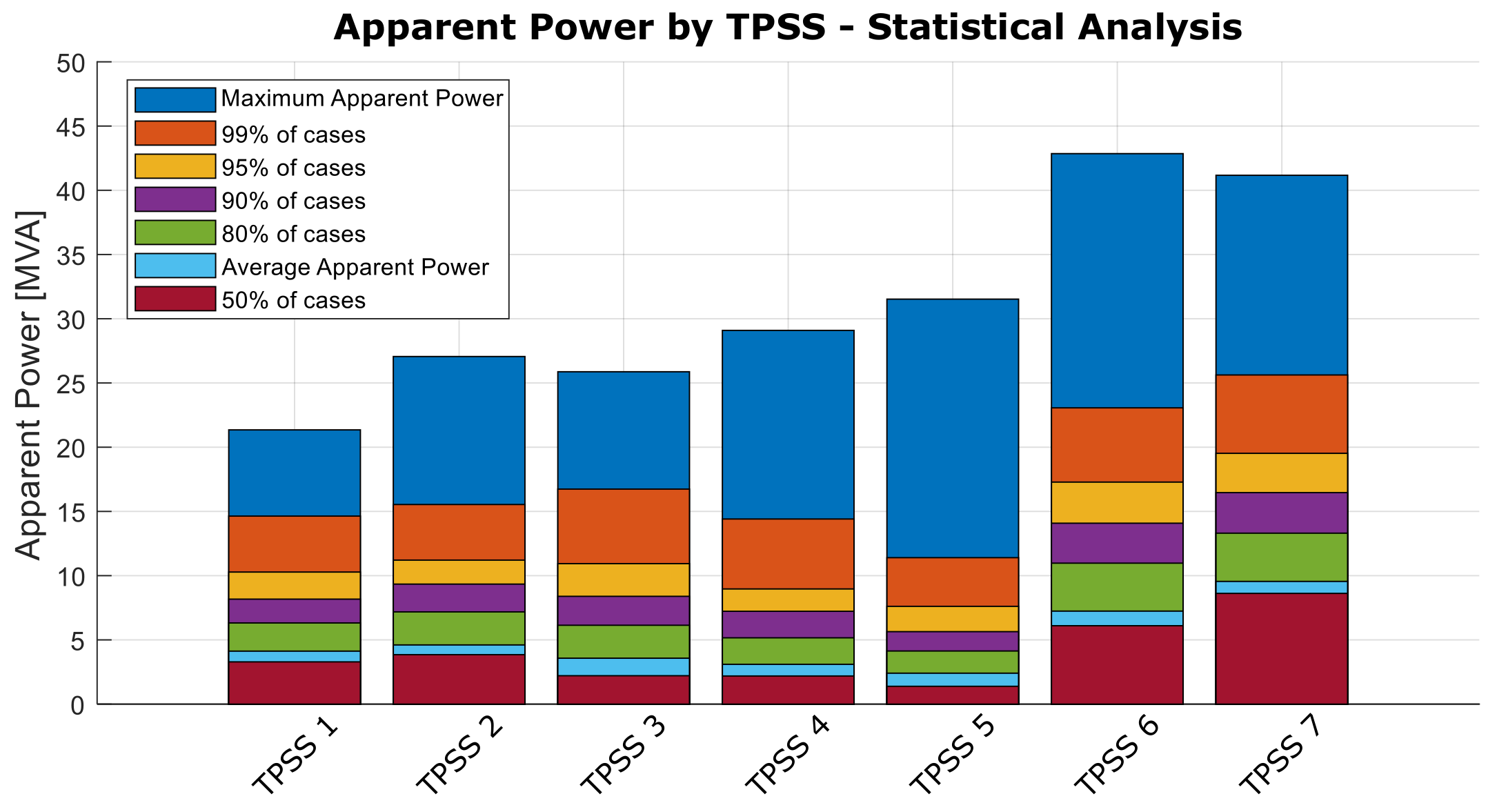
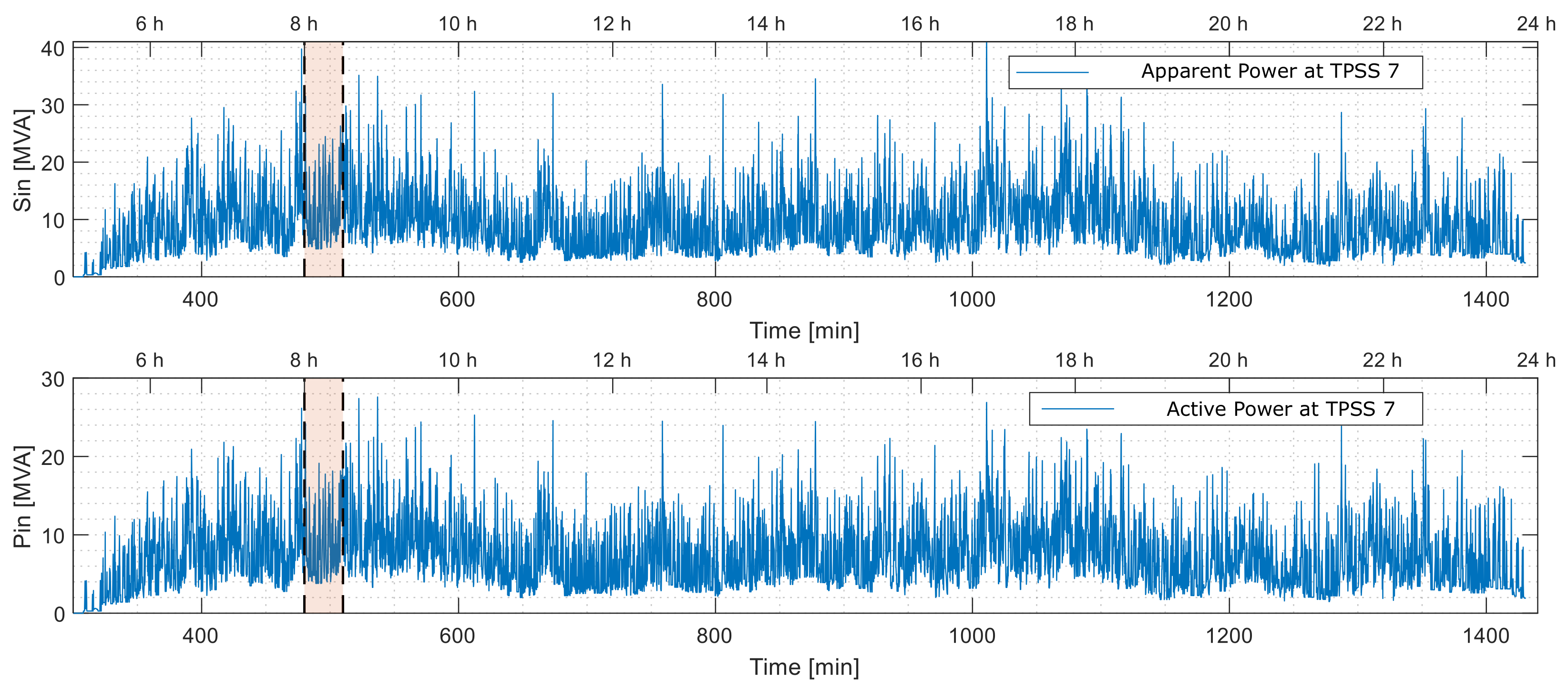


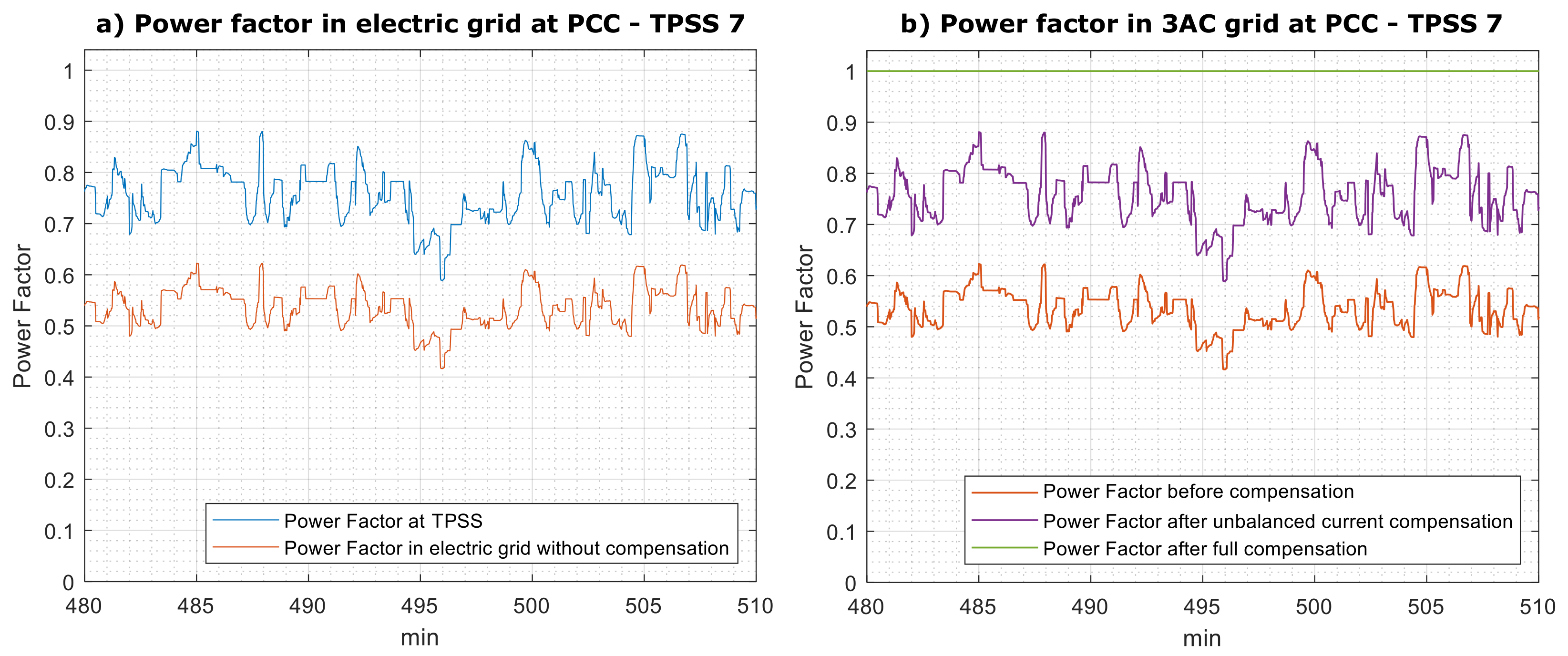
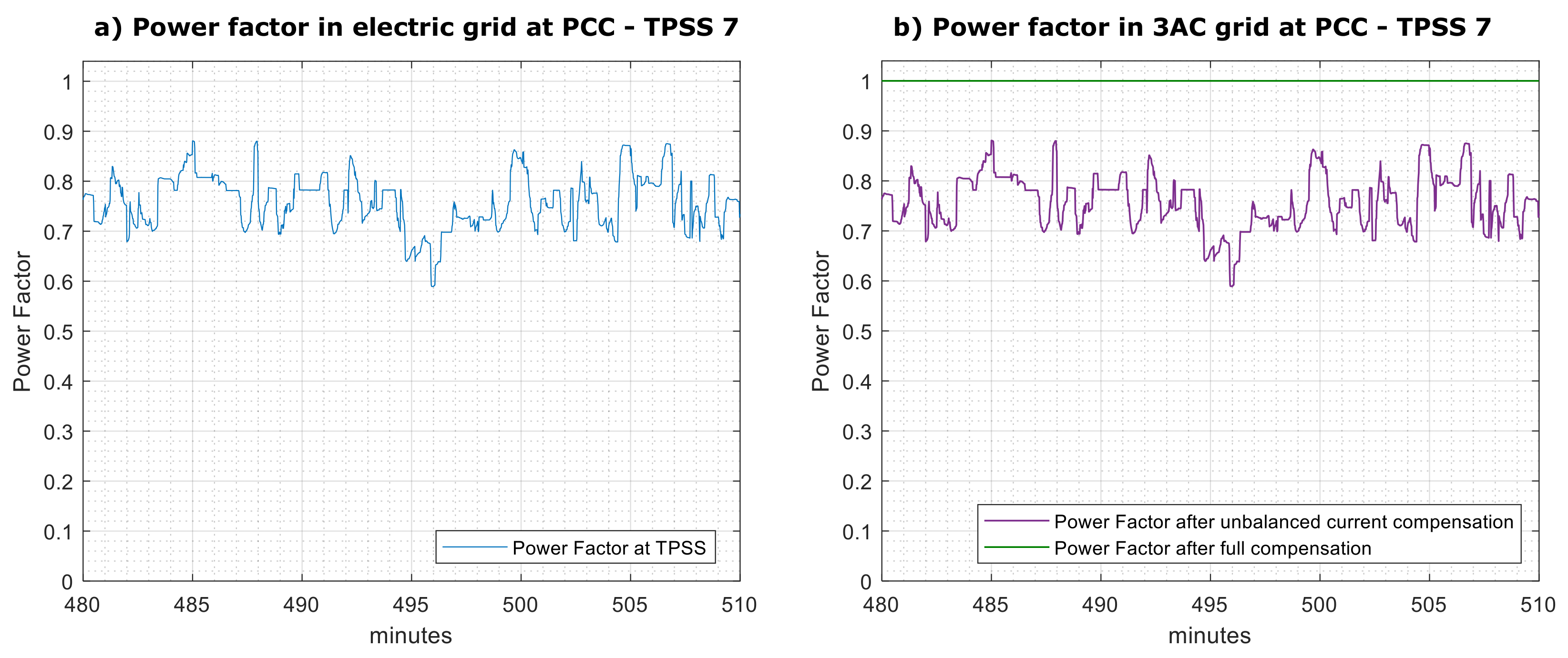
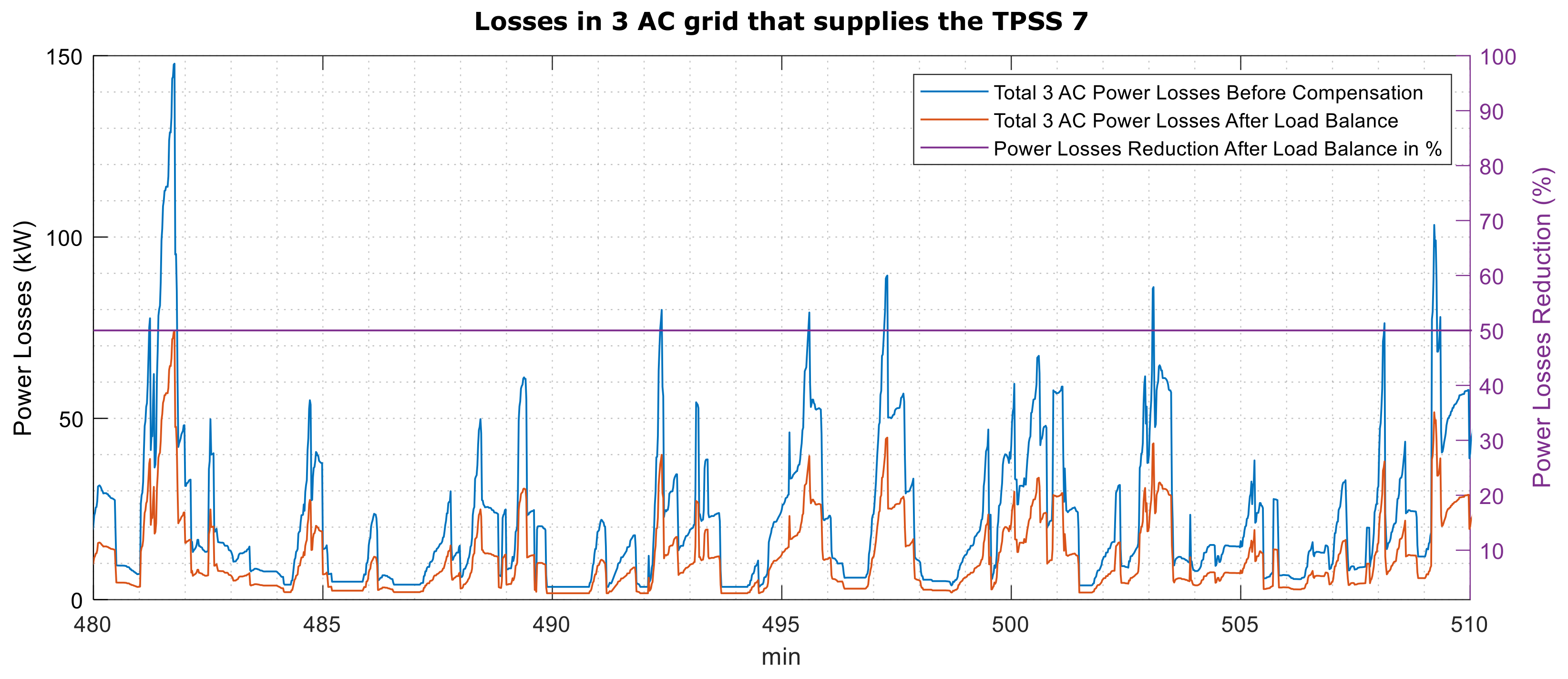
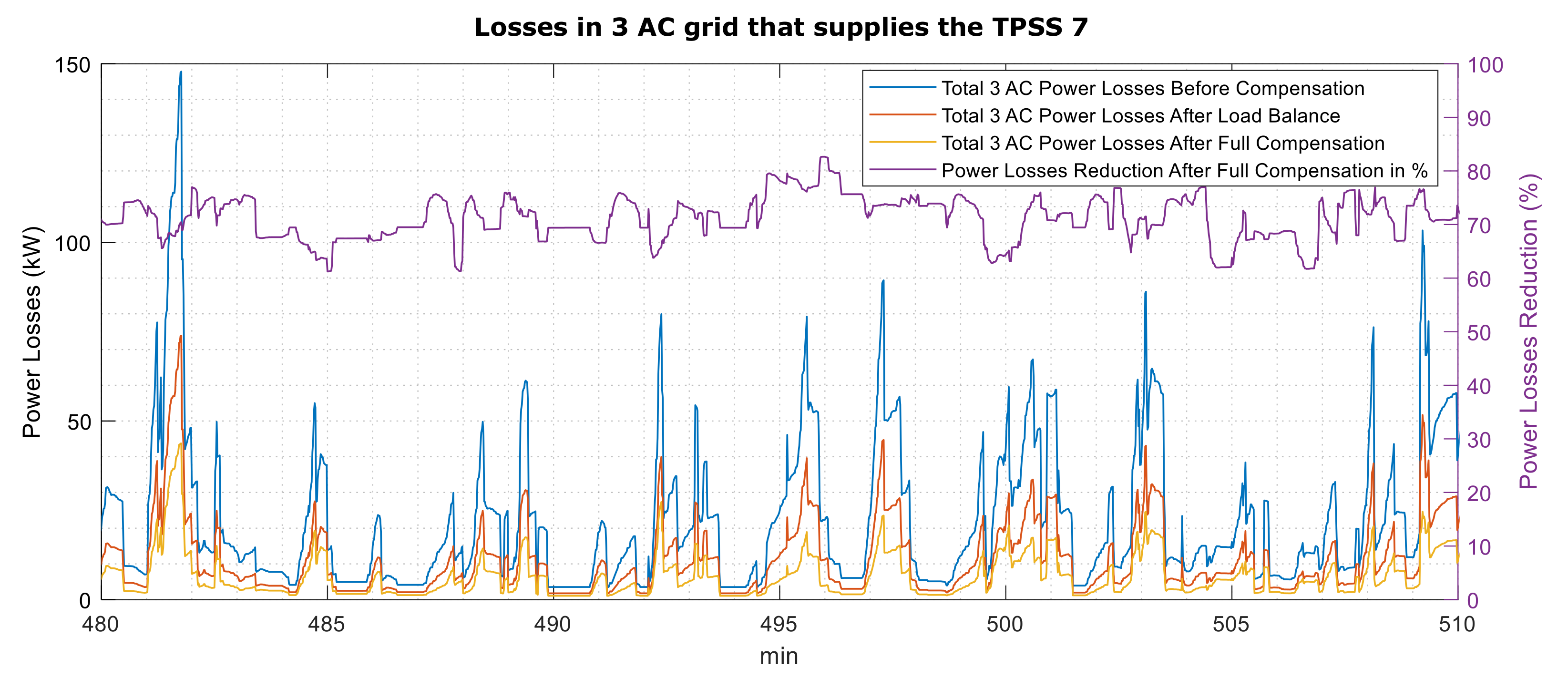

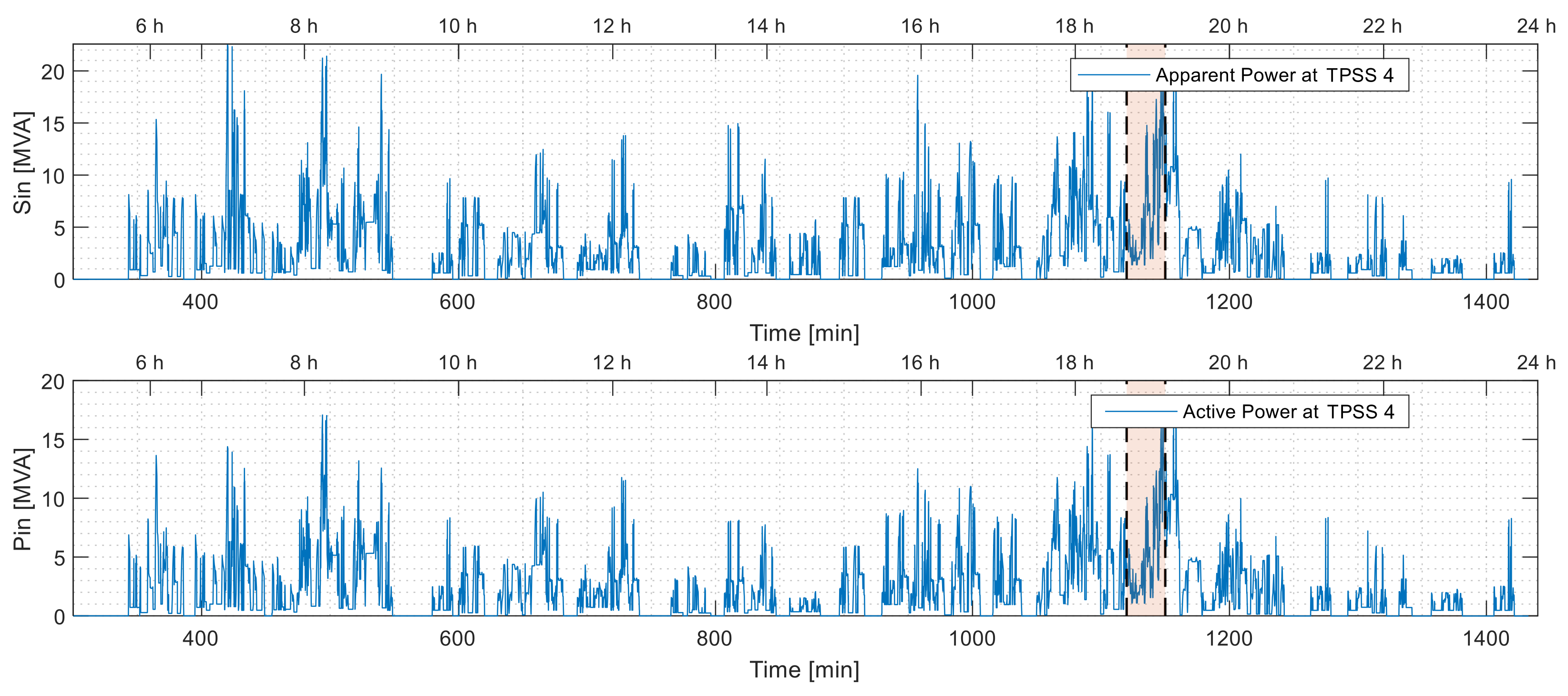
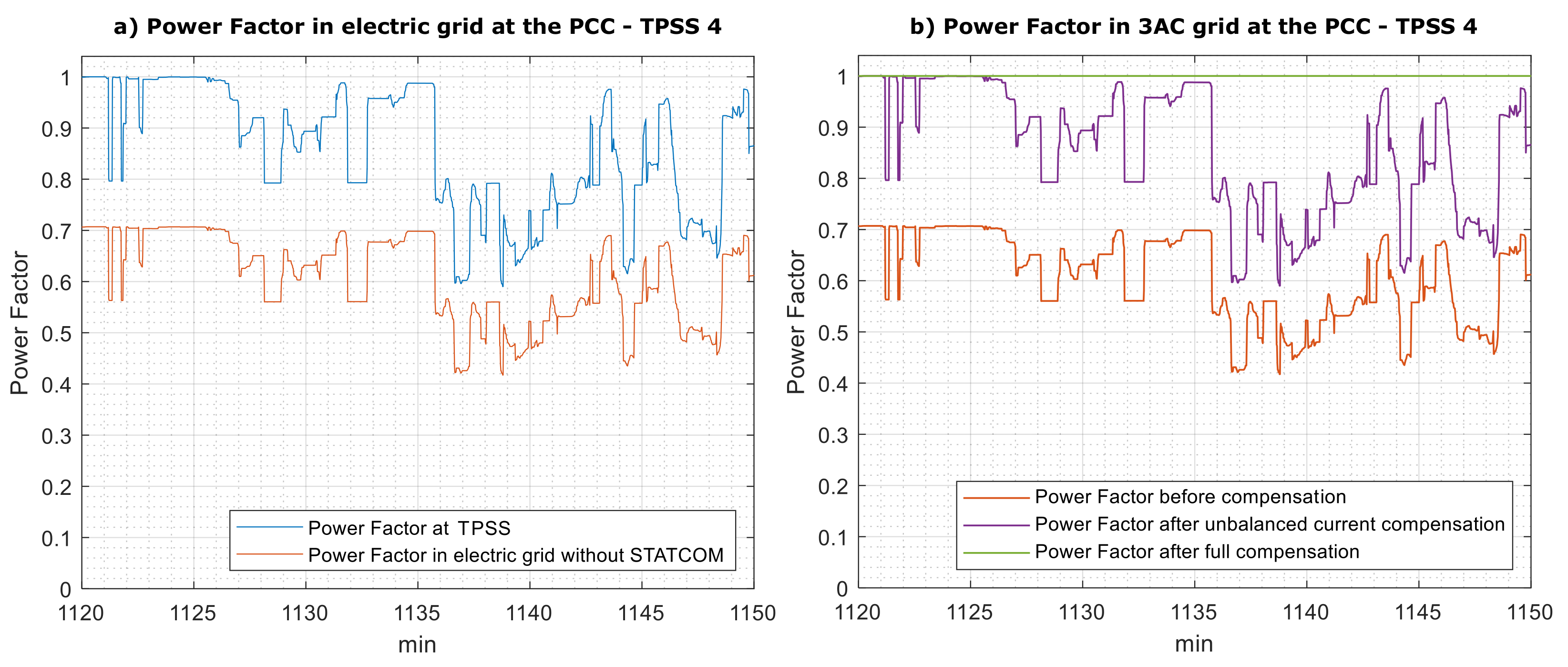
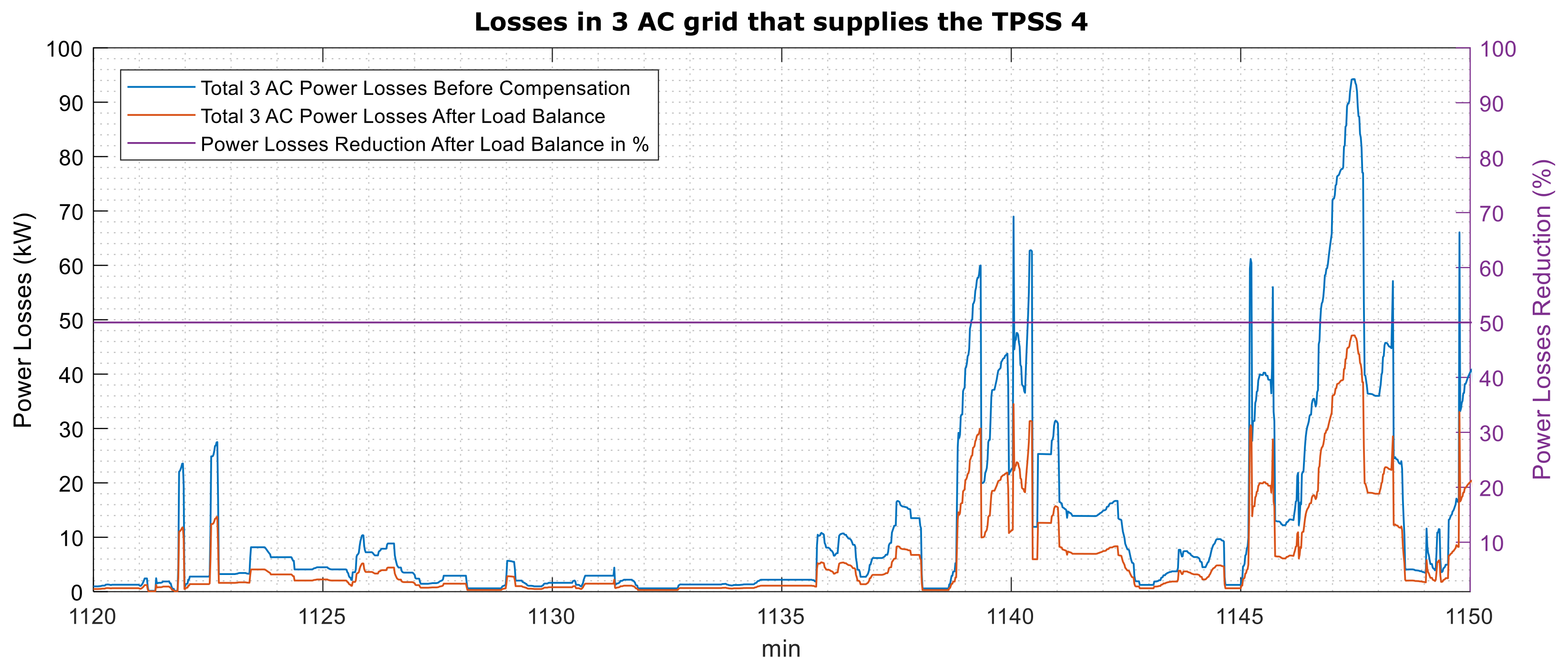
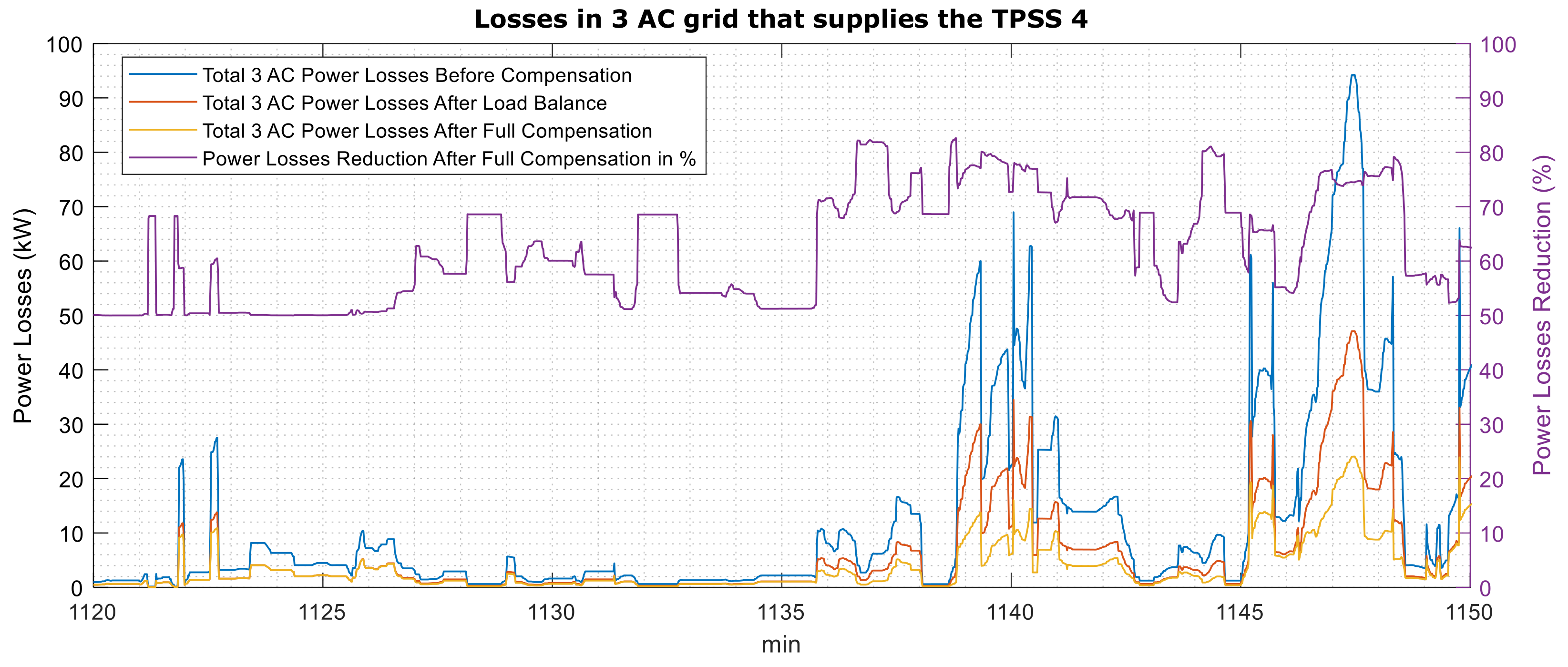


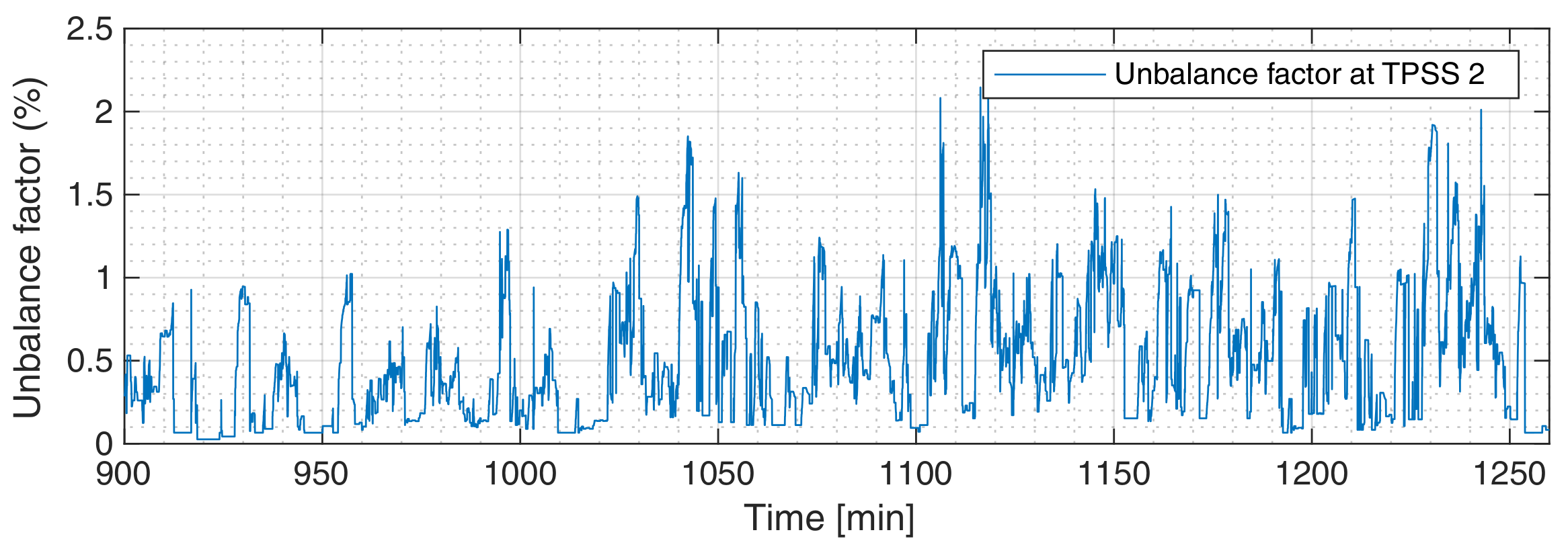
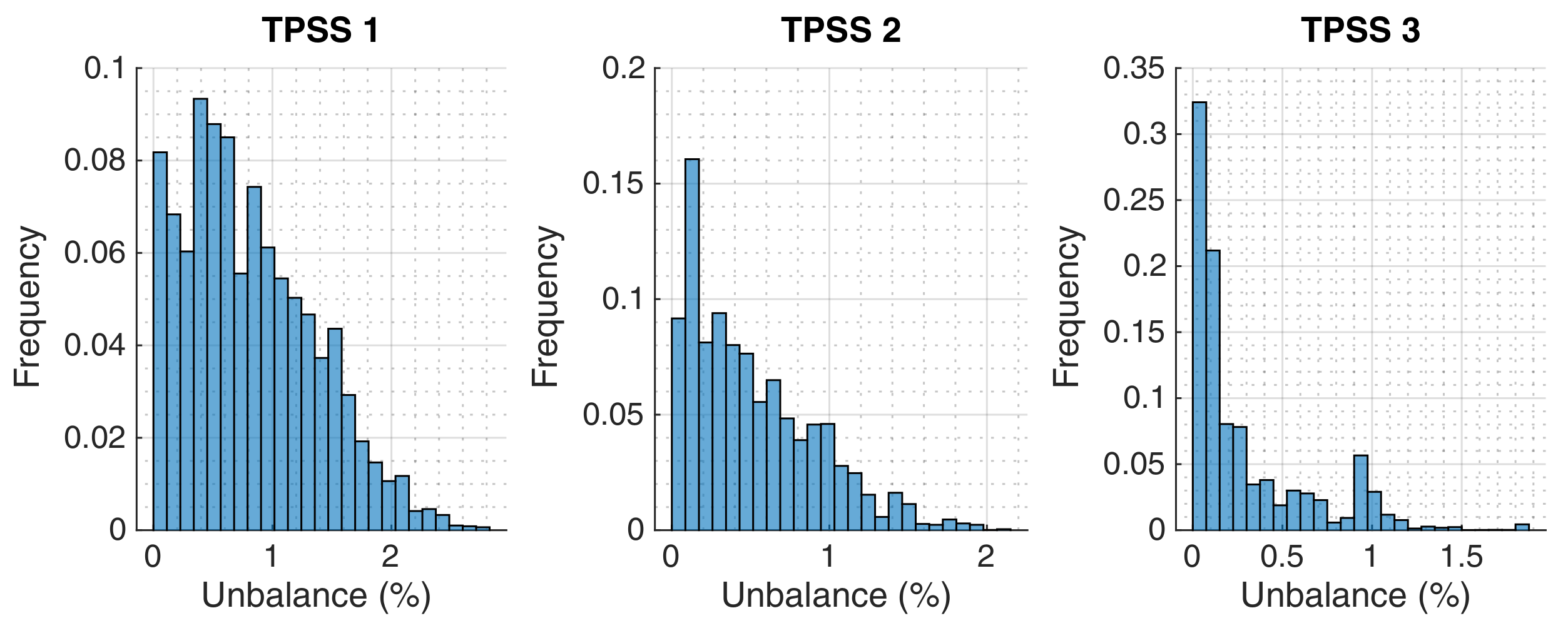
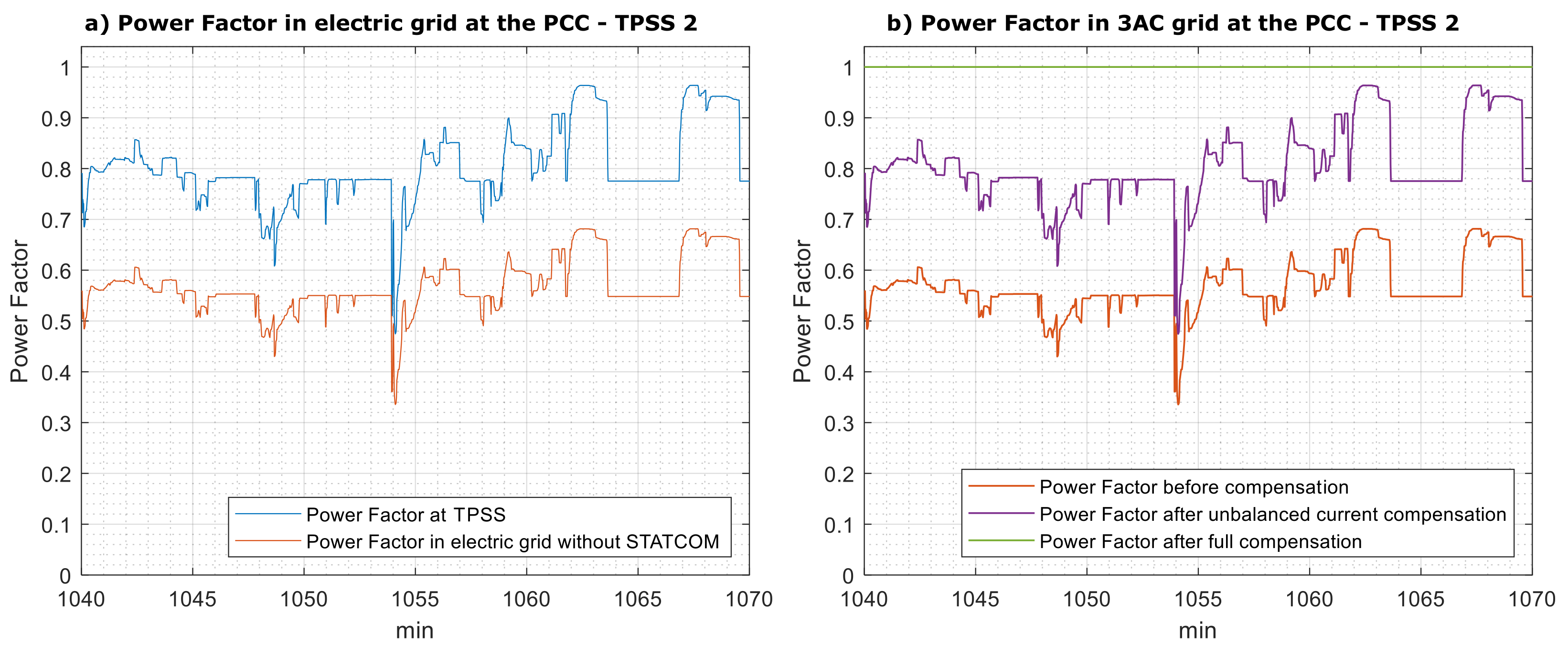
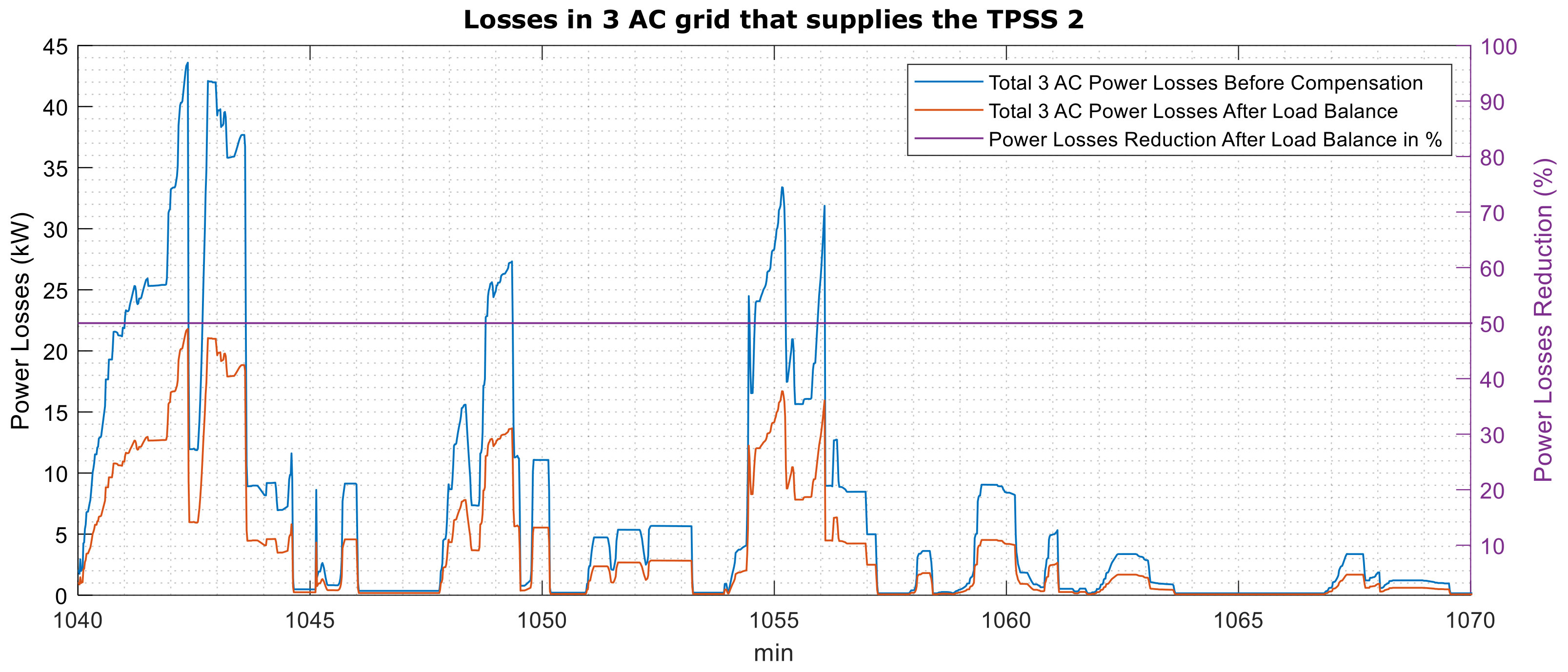
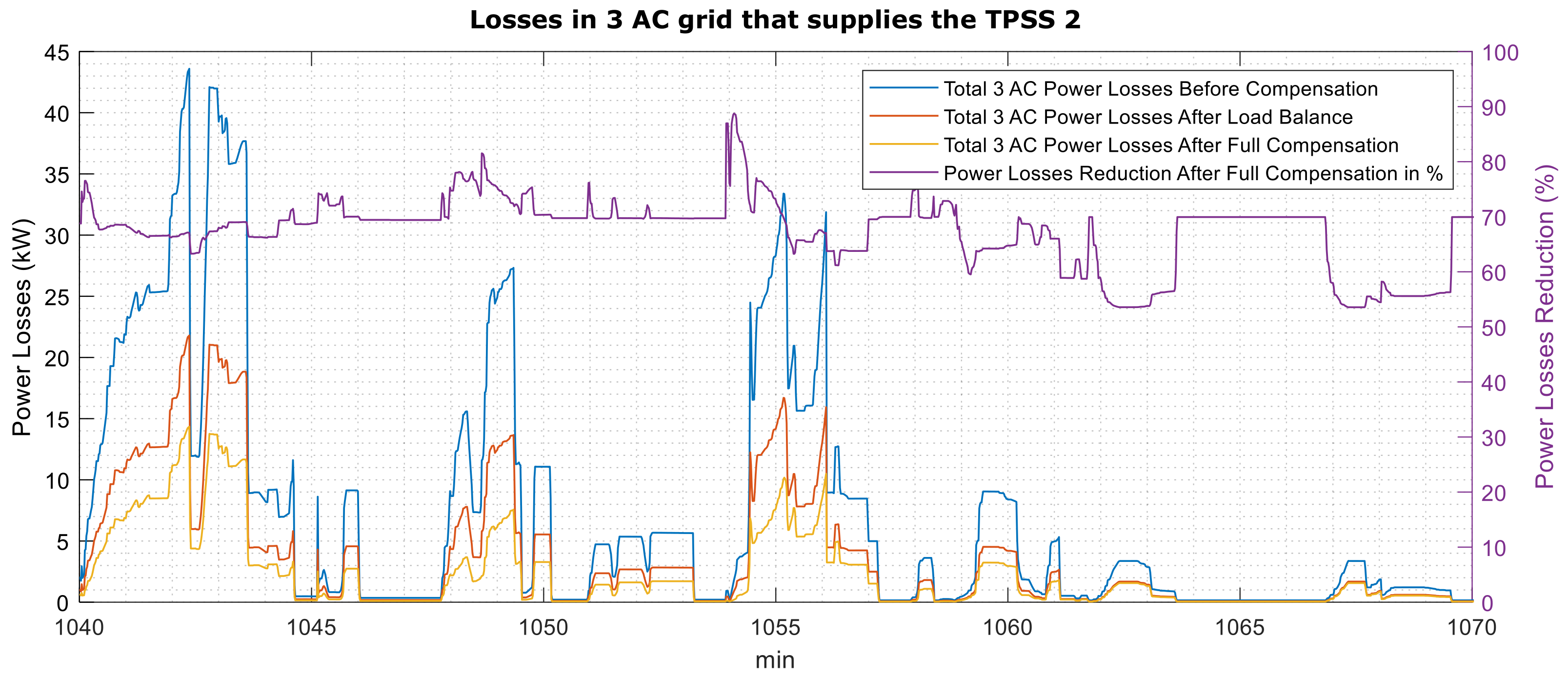
Publisher’s Note: MDPI stays neutral with regard to jurisdictional claims in published maps and institutional affiliations. |
© 2021 by the authors. Licensee MDPI, Basel, Switzerland. This article is an open access article distributed under the terms and conditions of the Creative Commons Attribution (CC BY) license (https://creativecommons.org/licenses/by/4.0/).
Share and Cite
Martins, A.P.; Rodrigues, P.; Hassan, M.; Morais, V.A. Voltage Unbalance, Power Factor and Losses Optimization in Electrified Railways Using an Electronic Balancer. Electricity 2021, 2, 554-572. https://doi.org/10.3390/electricity2040032
Martins AP, Rodrigues P, Hassan M, Morais VA. Voltage Unbalance, Power Factor and Losses Optimization in Electrified Railways Using an Electronic Balancer. Electricity. 2021; 2(4):554-572. https://doi.org/10.3390/electricity2040032
Chicago/Turabian StyleMartins, António P., Pedro Rodrigues, Mahmoud Hassan, and Vítor A. Morais. 2021. "Voltage Unbalance, Power Factor and Losses Optimization in Electrified Railways Using an Electronic Balancer" Electricity 2, no. 4: 554-572. https://doi.org/10.3390/electricity2040032
APA StyleMartins, A. P., Rodrigues, P., Hassan, M., & Morais, V. A. (2021). Voltage Unbalance, Power Factor and Losses Optimization in Electrified Railways Using an Electronic Balancer. Electricity, 2(4), 554-572. https://doi.org/10.3390/electricity2040032






